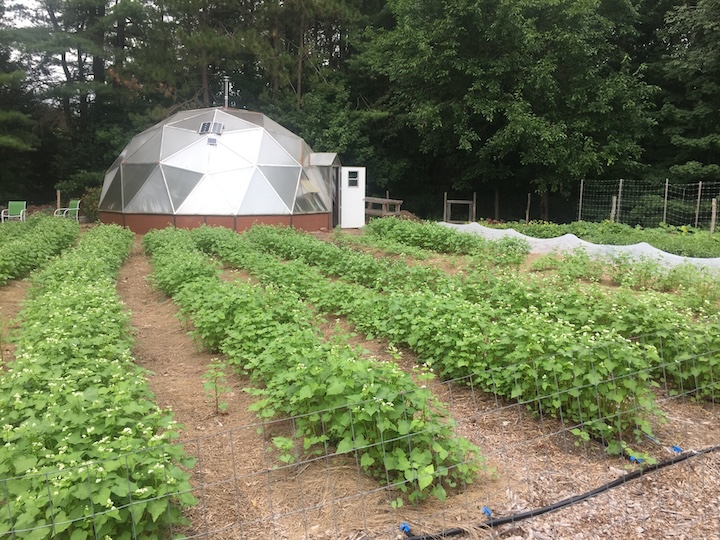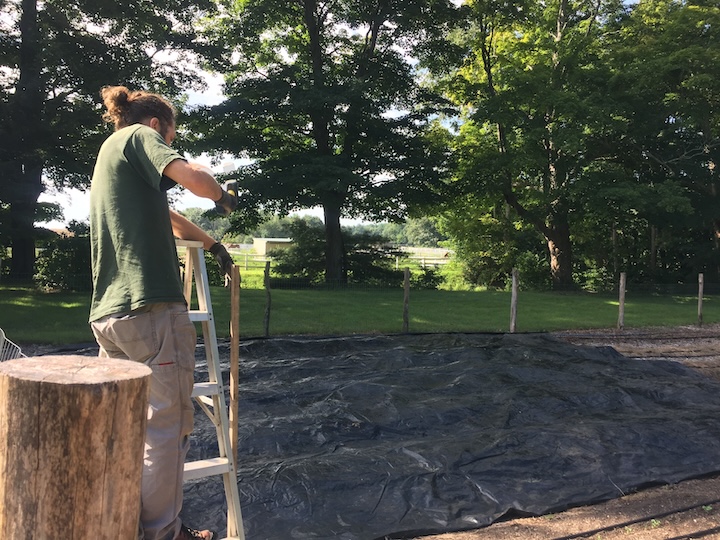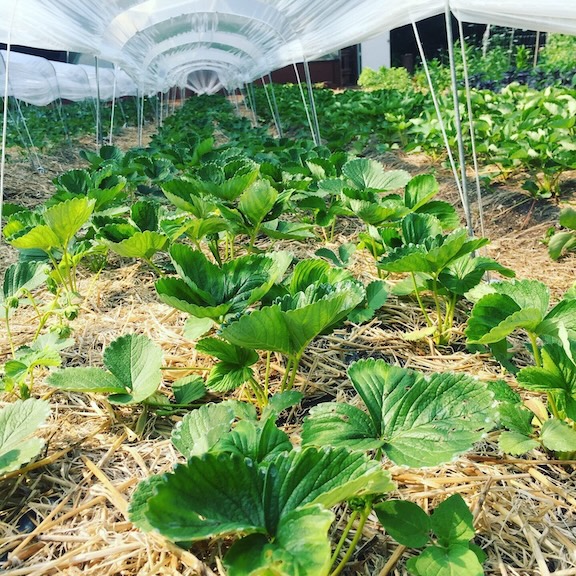By Jennifer Wilhelm
There is no single “right” way to practice no-till growing. As the name suggests, the core principle is straightforward: do not turn the soil over. Beyond that, the specifics of how to succeed within a no-till system are left to the discretion of individual growers. While people have employed no-till methods for thousands of years, best practices are still a topic of debate. However, most no-till growers agree on three fundamental principles: disturb the soil as little as possible, keep the soil covered, and maintain a living soil ecosystem. As a small-scale mixed vegetable and flower grower in Seacoast New Hampshire, I have been practicing these principles since 2013.
The second principle, keep the soil covered, is most commonly achieved through a practice known as mulching. Various types of mulch are available to growers, each with distinct advantages and disadvantages. Before exploring these options, it’s important to understand why a grower might choose to adopt a no-till system and why mulching is integral to its success.
Tilling the soil disrupts the microbial community, leading to compaction, soil erosion, reduced water-holding capacity, and nutrient loss. In contrast, no-till systems not only keep the soil intact but also build soil organic matter, a critical resource for crop health. While tilling can create loose soil for planting, kill weeds, and incorporate biomass into the soil profile, it comes with significant drawbacks. No-till systems offer an alternative by achieving similar benefits without the negative consequences of tillage. And on many no-till farms, including mine, tilthers (shallow cultivators) are used to lightly mix the top inch of soil to make it easier to direct sow.

One of the key challenges in no-till systems is managing weeds, which can quickly overtake growing areas and outcompete crops if left unchecked. Tilling can kill existing weeds but also brings dormant weed seeds to the soil surface, allowing them to germinate later in the season. By leaving the soil undisturbed and adding layers of compost or mulch, growers can smother weeds and reduce their presence over time. This approach keeps weed seeds buried and minimizes their impact on cash crops.
To succeed, no-till systems must create an environment conducive to crop growth while suppressing weeds. Mulching has proven to be an effective way to achieve this balance. By keeping the soil covered, mulch protects the soil ecosystem, enhances soil health, helps maintain a loose soil structure, and reduces weed pressure. Additionally, no-till systems contribute to carbon sequestration, helping mitigate climate change by trapping carbon in the soil.
Before deciding on a mulching strategy, the first step is to test the soil. Understanding the soil’s texture, organic matter content, micronutrient levels, microbial activity, and potential contaminants, such as heavy metals, provides a solid foundation for choosing the right mulch. Once the soil profile is understood, growers can select a mulching method that aligns with their goals and conditions.

Living mulch, also known as cover crops, offers numerous benefits but requires careful planning and maintenance. Cover crops include a wide variety of annual and perennial plants, such as oats, clover, and rye, each providing specific advantages. For instance, some cover crops fix nitrogen, others break up soil compaction, and many attract beneficial pollinators. Living mulch also addresses the third principle of no-till growing: maintaining a living soil ecosystem. While living mulch is cost-effective, growers must plan its use carefully, including selecting the appropriate crop, timing its planting (e.g., oats and peas in spring or rye and vetch in fall), and determining how to terminate it without creating new weed issues. On my farm, I often use silage tarp, made of thick black plastic, to kill back cover crops. I also rely on annual cover crops that easily winter-kill, allowing freezing temperatures to do the work for me.
The benefits of living mulch extend beyond soil health. These cover crops can improve biodiversity on the farm by providing habitat for beneficial insects and microorganisms. Additionally, they contribute to long-term sustainability by enhancing soil structure and increasing the soil’s resilience against extreme weather conditions. However, successful implementation requires understanding the unique needs of different crops and integrating them effectively into a no-till system.
Hay is another popular mulching option due to its accessibility and ease of application. It is affordable ($8-$12 per bale), easy to manage, and lasts for one or more growing seasons when applied in thick layers. Hay suppresses weeds, retains soil moisture, and is manageable by a single person. However, it can cool the soil, slowing crop growth during colder months, and may retain excess moisture, potentially causing root rot. The source of the hay is also critical, as it could contain pesticide or herbicide residues, or introduce weed seeds if harvested too late. Salt marsh hay, free from weed seeds, is a viable option for growers near coastal areas; it is what I use on my farm. Salt marsh hay can be pricier ($13 per bale), but I’ve found it is often slow to break down and can be used for two seasons.

In addition to its practical benefits, hay mulch can play a role in reducing soil erosion, particularly on slopes or in areas prone to heavy rainfall. By stabilizing the soil surface, hay helps prevent the loss of valuable topsoil and minimizes runoff, preserving the integrity of the growing area. This makes it an excellent choice for growers working in challenging environments.
Deep compost mulching (DCM) is another effective method, accessible to home gardeners and commercial farmers alike. This practice involves applying a thick layer of decomposed biomass (mature compost) to smother weed seeds and create a stale, nutrient-stable growing medium (one with no weed seeds and a low nitrogen-phosphorus-potassium ratio). DCM enhances soil water-holding capacity, supports the microbial community, and prepares beds for planting without introducing new nutrients; if DCM is done correctly, NPK ratios are less than 1-1-1. It’s important to note that DCM is not a substitute for targeted fertilization, which should be managed separately based on crop needs and soil conditions. Drawbacks of DCM include the potential difficulty of sourcing high-quality mature compost, the possible presence of contaminants like PFAS chemicals, cost, and the labor-intensive nature of application. Additionally, compost as a mulch layer can erode easily and may not prevent compaction as effectively as living mulch or hay.
Despite its challenges, DCM offers unique advantages for improving soil health over time. By gradually increasing organic matter content, this method supports the development of a robust soil structure that benefits both current and future crops. For growers willing to invest the effort, time, and money, DCM can be a useful tool in a no-till system.
Other mulches common to organic systems are plastic mulches and landscape fabrics, which are often used for their effectiveness in weed suppression and soil warming. These materials are relatively inexpensive upfront but sometimes require machinery to set in place. They also degrade over time, contributing to soil contamination. Plastic mulch must be replaced annually, leading to landfill waste. While landscape fabric is more durable, and its lifespan can be extended with careful use, its disposal ultimately poses environmental concerns as well.
Although not a sustainable long-term solution, plastic mulches can be valuable in specific situations, such as when early-season soil warming is critical for crop establishment. By using them judiciously, growers can balance the benefits of these materials with their environmental impact.
Complementary mulches, such as wood chips, cardboard, leaves, and grass clippings, can be used alongside primary mulching methods. Each has its own considerations. For instance, wood chips and cardboard may tie up nitrogen as they decompose, while leaves and grass clippings can introduce nutrients and organic matter to the soil. It’s also important to note that some cardboard may also introduce contaminants such as heavy metals and PFAS, and often contains glues. If the grass clippings are cut too late, they may include weed seeds, and depending on the source, may also contain chemical residues. While these materials are often readily available and cost-effective, making them attractive options for growers seeking to diversify their mulching practices, it’s important to understand the pros and cons of each.
Regardless of the mulching method chosen, the overarching goals of no-till systems remain the same: to create optimal growing conditions, build and maintain soil health, and produce abundant yields. The type and quantity of mulch will depend on soil type, environment, and available resources. By adhering to the principles of minimal soil disturbance, soil coverage, and fostering a living soil ecosystem, growers can achieve sustainable and productive no-till systems tailored to their unique needs.
The long-term benefits of no-till systems go beyond individual growing seasons. By prioritizing soil health and ecological balance, these systems contribute to the resilience of agricultural landscapes. As more growers adopt no-till practices and share their experiences, the collective understanding of best practices will continue to evolve, paving the way for innovative solutions and greater sustainability in farming.
Jennifer Wilhelm and her husband, Micum, cultivate 1 acre of no-till vegetables and flowers at Fat Peach Farm in Madbury, New Hampshire.
This article originally appeared in the spring 2025 issue of The Maine Organic Farmer & Gardener.
